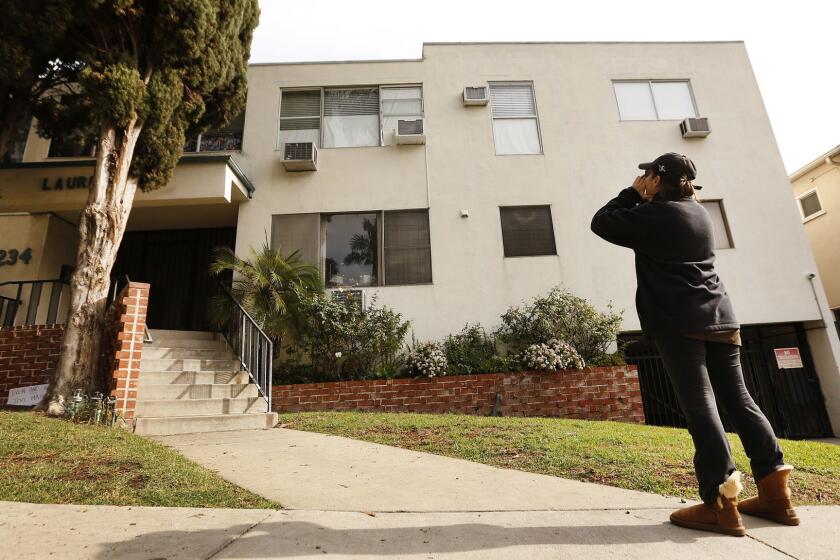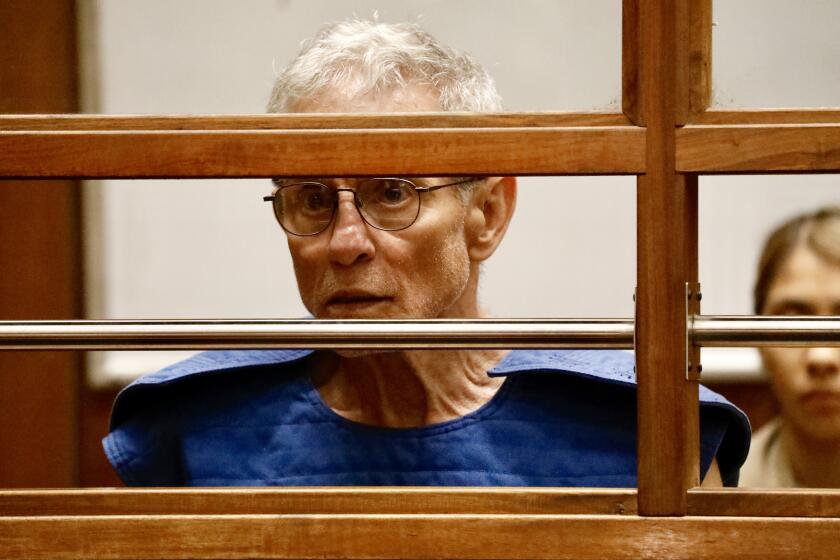Man who prompted investigation of Democratic donor Ed Buck found dead on South L.A. sidewalk

- Share via
Dane Brown, who survived a 2019 drug overdose and prompted an investigation against Democratic donor and activist Ed Buck, was found dead on a South Los Angeles sidewalk last week.
Brown’s call to police and his testimony helped lead a jury to convict Buck of luring young, Black men into his West Hollywood apartment for nearly a decade for “party and play” sessions that involved sex and heavy drug use. Two men died in Buck’s apartment in 2017 and 2019 from drug overdoses.
“I don’t think [Brown] really knew the impact that he had,” said Jasmyne Cannick, a political consultant, writer and friend of Brown’s.
Brown was found dead on a sidewalk in South Los Angeles on Nov. 6, according to the L.A. County medical examiner’s office. A cause of death has not yet been determined.
The men lured to Buck’s apartment, who were often homeless and addicted, were plied with drugs during the encounters and were often offered extra money if they allowed Buck to inject them with drugs. If they refused, Buck would sometimes refuse to pay them.
For years, victims and advocates tried to call attention to the dangerous encounters at Buck’s apartment. But it wasn’t until Brown managed to escape Buck’s apartment, staggered to a gas station after being injected with three doses of methamphetamine and called 911, that Buck was arrested. Buck was eventually charged and convicted with supplying drugs to Gemmel Moore, 26, and Timothy Dean, 55, who died of overdoses at his home in 2017 and 2019, respectively. He was sentenced to 30 years in prison.
Residents of a two-story Laurel Avenue apartment complex in West Hollywood stood on the building’s front porch as dozens of protesters shouted at them.
After Buck’s conviction, Cannick said Brown was working a job and found an apartment that he was proud to show friends.
He insisted on taking her out to dinner at a barbecue restaurant on La Brea Avenue to repay her for her help.
But Brown continued to struggle with his mental health and drug addiction, she said. He lost his apartment and would go missing at times.
“He tried, he tried very hard,” she said. “Ultimately, it was a bigger struggle than he could deal with.”
Cannick said Brown was found dead near Vernon and McKinley avenues, across the street from the apartment where he temporarily lived.
Buck’s two-week trial highlighted a dangerous underworld of sex work, where an influential, wealthy man exploited poor, addicted Black men.
“My heart is broken,” Cannick said in a video speaking about her friend’s death. “Dane, who I got to know really well, was really struggling and trying to put his life back together post-Ed Buck.”
Brown, Cannick said, loved to cook and play games and referred to himself as a geek.
“When the cameras were gone, he was just another Black man in L.A. trying to make it, and that’s just not easy, especially in a city like Los Angeles,” she said. “I am incredibly sad for his family, for his friends, for all of us that worked with him, that knew him, that were championing him and supporting him.”
Brown’s decision to contact authorities, and to ultimately testify at Buck’s trial, was a pivotal moment that helped lead to the Democratic donor’s conviction, and for other victims to come forward, said one of his attorneys, Nana Gyamfi.
“Dane was critical to the case,” she said.
Brown’s survival and willingness to talk to law enforcement helped ensure the case was impossible to ignore, Gyamfi said. His involvement helped her persuade other victims to come forward and testify.
“It was his escape — he is literally the person who undid the ribbon, so to speak,” she said. “It was his escape, and him reaching out to the police that they couldn’t ignore that.”
Ed Buck, a fixture of West Hollywood politics, was convicted of charges that he supplied the methamphetamine that killed two men during “party and play” encounters at his apartment.
Brown also filed a lawsuit against Buck, alleging sexual battery, assault, hate violence, emotional distress and human trafficking. The case had been set to go to trial in February.
According to the lawsuit, since Buck’s arrest, Brown had continued to be periodically homeless and suffered from disabling medical conditions.
The suit alleges that Buck caused Brown to suffer two methamphetamine overdoses in one week in September 2019, including the one that ultimately led to Buck’s arrest.
Brown lived with Buck for three months and Buck “would supply and intravenously inject methamphetamine into Mr. Brown on a daily basis,” the lawsuit alleges.
According to court records, attorneys for Brown intend to continue the suit against Buck and are working to name a representative to continue it.
Gyamfi and Cannick said they had lost contact with Brown around August. Although he often stayed in touch via phone calls and text messages, the messages had stopped coming for some time.
His death is particularly difficult, Gyamfi said, because Brown had shown her he was persistently fighting to improve himself and, in the most dire of circumstances at times, to live.
“He fought to live, and that’s how this case broke open,” she said. “He escaped the jaws of death only to die, presumably, by himself on the sidewalk — one of the six people who die every day in the city of Los Angeles unhoused. He had a desire to live.”
More to Read
Sign up for Essential California
The most important California stories and recommendations in your inbox every morning.
You may occasionally receive promotional content from the Los Angeles Times.













